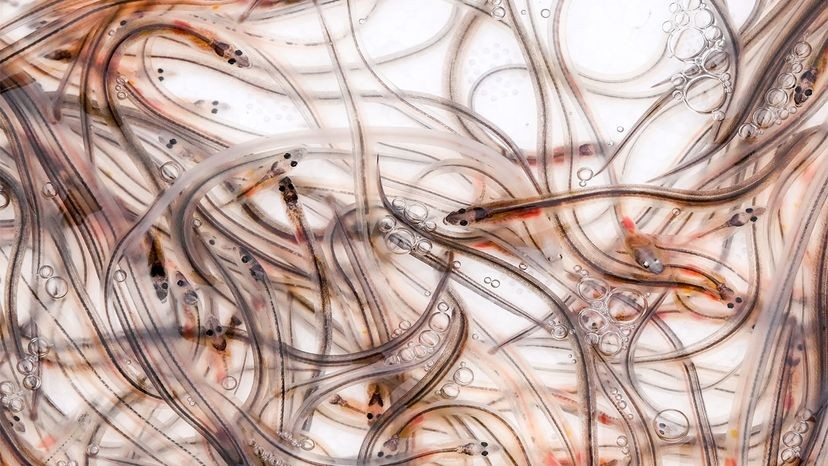Eels, those elongated and often misunderstood fish, spark curiosity with a frequently asked question online: How Do Eels Reproduce? These fascinating creatures, sometimes seen gliding through aquariums or featured on seafood menus, have captivated researchers for millennia. Yet, despite centuries of study, the intricacies of their reproductive lives remain largely enigmatic.
To shed light on the secrets of eel reproduction, we consulted with Caroline Durif, an esteemed ecologist from the Institute of Marine Research in Storebø, Norway. Her expertise in eel behavior provides valuable insights into these remarkable fish. Let’s delve into what we know about how eels make more eels.
Decoding the Eel: What Defines a True Eel?
Before exploring their reproduction, it’s crucial to understand what constitutes a “true eel.” The term “eel” is loosely applied, often causing confusion. Take the electric eel (Electrophorus electricus) of South America, for example. Despite its common name, this electrifying fish is not a true eel but rather a unique relative of carp, classified as a knife fish.
True eels belong to the order Anguilliformes, encompassing over 800 diverse species. This group includes moray eels, recognizable as Ursula’s serpentine sidekicks from “The Little Mermaid,” along with conger eels and the aptly named spaghetti eels.
True eels are typically characterized by their slender, elongated bodies and the absence of pelvic fins, those paired fins found on the underside of many other fish. Many species also lack scales, giving them a characteristically slippery feel.
While most eels thrive in saltwater environments, a notable exception exists: the 19 species of freshwater eels, also known as Anguillids. These eels exhibit a fascinating life cycle, spending a significant portion of their lives in freshwater while returning to the ocean to reproduce, as Durif explains. Among these, the European eel (Anguilla anguilla), the American eel (Anguilla rostrata), and the Japanese eel (Anguilla japonica) are perhaps the most well-known.
The Remarkable Early Life Stages of an Eel
The life cycle of freshwater eels is nothing short of extraordinary, marked by five distinct stages, each accompanied by significant physical and behavioral transformations.
“The initial stage is the leptocephalus larva. The name itself is derived from Greek, where ‘lepto‘ signifies leaf and ‘cephalus‘ means head,” Durif clarifies.
This name aptly describes the larvae’s appearance: their bodies are leaf-shaped, broad, and flattened when viewed from the side, a characteristic described technically as “laterally compressed.” Adding to their elusiveness, leptocephalus larvae are nearly transparent, rendering them remarkably camouflaged in the vast ocean.
Leptocephalus larvae begin their lives in the ocean, drifting with currents. Driven by instinct, they embark on extensive migrations, carried by currents like the Gulf Stream. Upon reaching the continental shelf, they undergo metamorphosis into the next life stage.
“For the anguillids, they undertake long migrations, drifting through the Gulf Stream. Upon reaching the continental shelf, they transform into glass eels,” Durif elaborates. Glass eels retain a degree of transparency but become more elongated and slender compared to their larval form.
 Glass eels caught on the French Atlantic coast in 2021, showcasing their transparent bodies after a migration of approximately 2,796 miles (4,500 kilometers) from the Gulf of Mexico.
Glass eels caught on the French Atlantic coast in 2021, showcasing their transparent bodies after a migration of approximately 2,796 miles (4,500 kilometers) from the Gulf of Mexico.
These glass eels, captured off the French Atlantic coast in 2021, exemplify this stage. By this point, they have already completed an astounding journey of around 2,796 miles (4,500 kilometers) from the Gulf of Mexico, traversing the Atlantic over one to two years.
The Journey to Maturity: Yellow and Silver Eels
Drawn to freshwater, as Durif notes, most anguillid glass eels instinctively migrate inland, venturing upstream into rivers. This marks the transition to the third life stage: the “yellow eel.” Unlike their transparent predecessors, yellow eels develop body pigmentation, exhibiting a yellowish hue overall. However, this is not their final color phase.
“When they are ready to mature, they transform into silver eels, akin to reaching puberty,” Durif explains. “We call them ‘silver’ eels due to their characteristic silver belly and a dark, black dorsal area… This coloration serves as an adaptation against predators.”
This transformation is a gradual process, with the transition from yellow to silver eel potentially spanning two to three decades. Once complete, silver eels are driven to return to their oceanic origins, heading seaward. Only at this stage do eels attain sexual maturity, the fifth and final phase of their remarkable life cycle, preparing them for reproduction.
The Elusive Reproductive Stage and Final Days
The reproductive phase of anguillid eels remains shrouded in mystery. As highlighted in a 2021 study co-authored by Durif and published in Fish and Fisheries, “sexually mature eels have never been caught alive in the wild.” This lack of direct observation underscores the challenges in understanding their reproductive behavior.
Similarly, scientists have yet to witness these eels spawning in their natural habitat. Wild anguillids engaging in the act of reproduction have never been observed by researchers.
Current scientific understanding suggests that freshwater eels likely die shortly after spawning. Laboratory studies have successfully induced sexual maturity in silver eels through hormone injections. However, this induced maturity is accompanied by a decline in health. “Their bones undergo decalcification, similar to what occurs in women during menopause. It’s truly fascinating. Furthermore, their digestive system, their gut, regresses,” Durif notes, highlighting the significant physiological changes associated with reproduction.
This physical decline may be linked to the environment where breeding-age freshwater eels congregate. These locations likely lack their typical food sources, such as insects and small fish, suggesting that reproduction is their final biological imperative.
The Sargasso Sea and Other Spawning Mysteries
Within the Atlantic Ocean lies the Sargasso Sea, a unique region defined not by land boundaries but by powerful ocean currents. This sea serves as a crucial destination for both American and European eels, who converge here to reproduce. Research indicates that they may utilize magnetic fields as a navigational aid to reach this remote location.
Halfway across the globe, freshwater eels inhabiting the Pacific Ocean region have their own distinct spawning grounds. The Japanese eel is believed to breed west of the Mariana Islands, while other species may reproduce in areas between New Caledonia and Fiji.
“The European eel undertakes the most extensive migration,” Durif points out, with some individuals journeying approximately 4,971 miles (8,000 kilometers) from Norway to reach the Sargasso Sea.
Eel reproduction involves the release of eggs into the water, where they are fertilized by clouds of sperm. This method is common to both freshwater eels and non-freshwater species, including moray eels and conger eels.
Intriguingly, Durif notes that “we possess even less knowledge about conger eel reproduction than anguillid eels.” “We suspect the existence of at least one spawning area, possibly in the Mediterranean,” she adds. Future research is essential to unravel the mysteries surrounding their reproductive habits.
Now That’s Interesting
Eels exhibit fascinating feeding behaviors. Some eels employ a multi-step feeding process, sucking food into their mouths and then breaking it down into smaller pieces through shaking or twisting motions. Moray eels, on the other hand, possess a startling second set of jaws to effectively capture and subdue prey, showcasing the diverse adaptations within the eel world.
The question of how eels reproduce continues to intrigue scientists and nature enthusiasts alike. While significant progress has been made in understanding their complex life cycle, the actual act of reproduction in their natural environment remains an elusive secret, urging further exploration into the depths of these captivating creatures’ lives.
